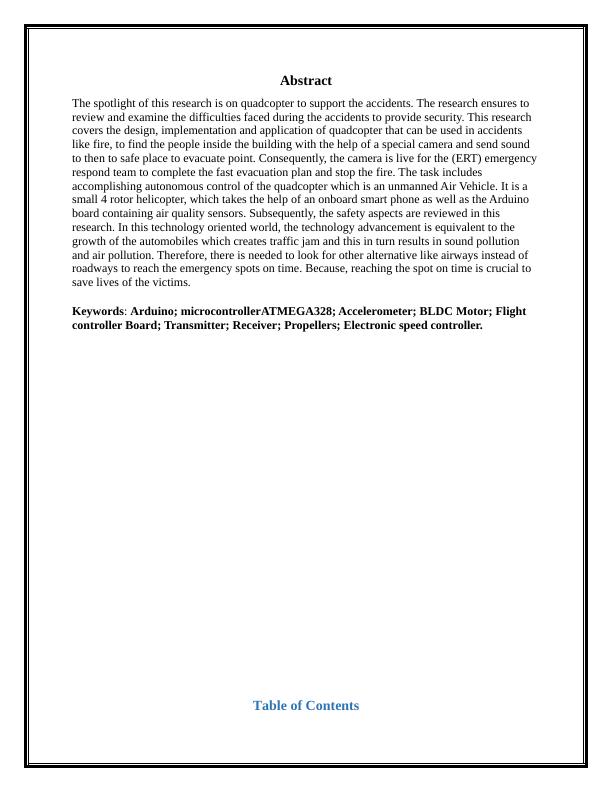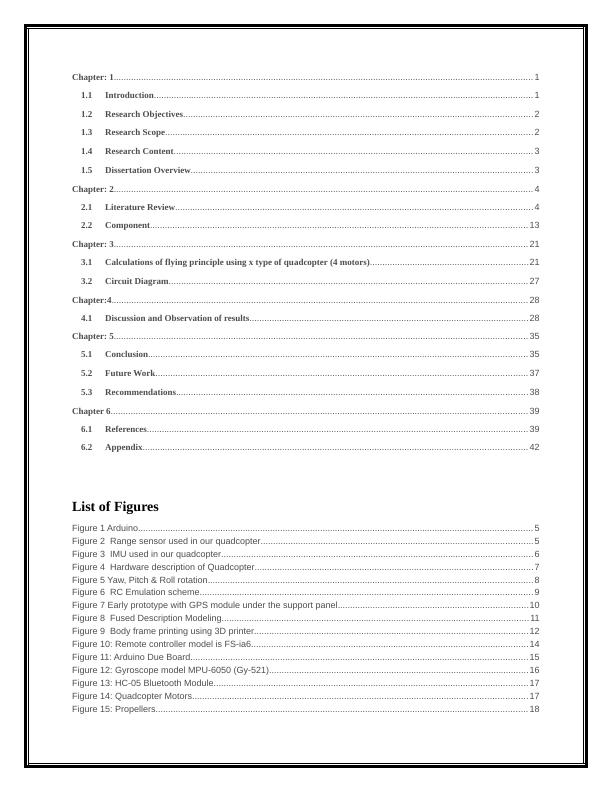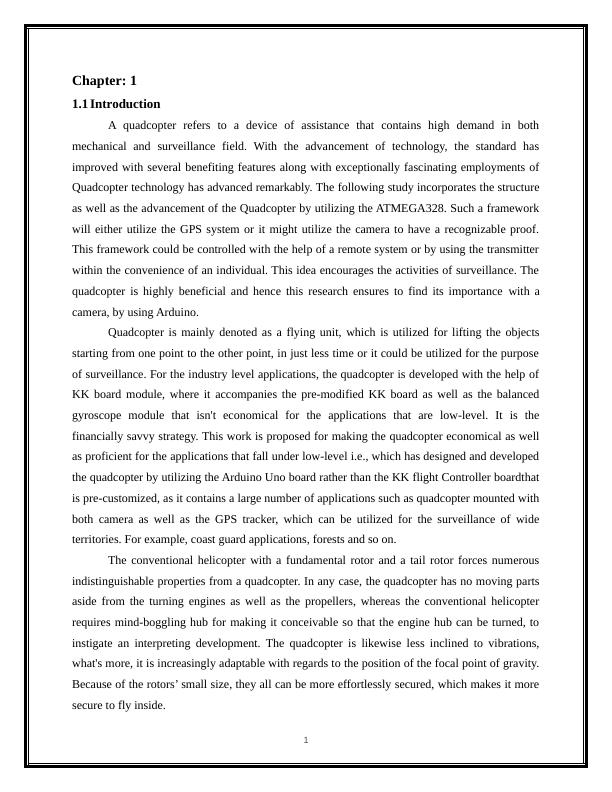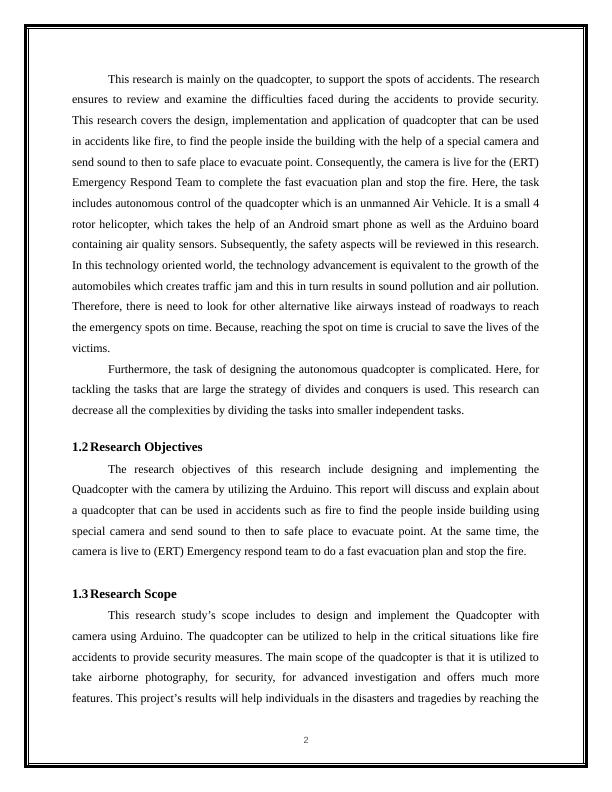Quadcopter with Camera: Design, Implementation, and Application
56 Pages12253 Words131 Views
Added on 2023-04-21
About This Document
This research covers the design, implementation and application of quadcopter that can be used in accidents like fire, to find the people inside the building with the help of a special camera and send sound to then to safe place to evacuate point.
Quadcopter with Camera: Design, Implementation, and Application
Added on 2023-04-21
ShareRelated Documents
University
*** Semester
A Final Year Project
on
Quadcopter with Camera
Student Name:
Register Number:
Submission Date:
*** Semester
A Final Year Project
on
Quadcopter with Camera
Student Name:
Register Number:
Submission Date:

Abstract
The spotlight of this research is on quadcopter to support the accidents. The research ensures to
review and examine the difficulties faced during the accidents to provide security. This research
covers the design, implementation and application of quadcopter that can be used in accidents
like fire, to find the people inside the building with the help of a special camera and send sound
to then to safe place to evacuate point. Consequently, the camera is live for the (ERT) emergency
respond team to complete the fast evacuation plan and stop the fire. The task includes
accomplishing autonomous control of the quadcopter which is an unmanned Air Vehicle. It is a
small 4 rotor helicopter, which takes the help of an onboard smart phone as well as the Arduino
board containing air quality sensors. Subsequently, the safety aspects are reviewed in this
research. In this technology oriented world, the technology advancement is equivalent to the
growth of the automobiles which creates traffic jam and this in turn results in sound pollution
and air pollution. Therefore, there is needed to look for other alternative like airways instead of
roadways to reach the emergency spots on time. Because, reaching the spot on time is crucial to
save lives of the victims.
Keywords: Arduino; microcontrollerATMEGA328; Accelerometer; BLDC Motor; Flight
controller Board; Transmitter; Receiver; Propellers; Electronic speed controller.
Table of Contents
The spotlight of this research is on quadcopter to support the accidents. The research ensures to
review and examine the difficulties faced during the accidents to provide security. This research
covers the design, implementation and application of quadcopter that can be used in accidents
like fire, to find the people inside the building with the help of a special camera and send sound
to then to safe place to evacuate point. Consequently, the camera is live for the (ERT) emergency
respond team to complete the fast evacuation plan and stop the fire. The task includes
accomplishing autonomous control of the quadcopter which is an unmanned Air Vehicle. It is a
small 4 rotor helicopter, which takes the help of an onboard smart phone as well as the Arduino
board containing air quality sensors. Subsequently, the safety aspects are reviewed in this
research. In this technology oriented world, the technology advancement is equivalent to the
growth of the automobiles which creates traffic jam and this in turn results in sound pollution
and air pollution. Therefore, there is needed to look for other alternative like airways instead of
roadways to reach the emergency spots on time. Because, reaching the spot on time is crucial to
save lives of the victims.
Keywords: Arduino; microcontrollerATMEGA328; Accelerometer; BLDC Motor; Flight
controller Board; Transmitter; Receiver; Propellers; Electronic speed controller.
Table of Contents

Chapter: 1........................................................................................................................................................................ 1
1.1 Introduction........................................................................................................................................................ 1
1.2 Research Objectives............................................................................................................................................ 2
1.3 Research Scope................................................................................................................................................... 2
1.4 Research Content................................................................................................................................................ 3
1.5 Dissertation Overview......................................................................................................................................... 3
Chapter: 2........................................................................................................................................................................ 4
2.1 Literature Review............................................................................................................................................... 4
2.2 Component....................................................................................................................................................... 13
Chapter: 3...................................................................................................................................................................... 21
3.1 Calculations of flying principle using x type of quadcopter (4 motors)...............................................................21
3.2 Circuit Diagram................................................................................................................................................ 27
Chapter:4....................................................................................................................................................................... 28
4.1 Discussion and Observation of results................................................................................................................28
Chapter: 5...................................................................................................................................................................... 35
5.1 Conclusion........................................................................................................................................................ 35
5.2 Future Work..................................................................................................................................................... 37
5.3 Recommendations............................................................................................................................................. 38
Chapter 6....................................................................................................................................................................... 39
6.1 References......................................................................................................................................................... 39
6.2 Appendix.......................................................................................................................................................... 42
List of Figures
Figure 1 Arduino.............................................................................................................................................................. 5
Figure 2 Range sensor used in our quadcopter.............................................................................................................5
Figure 3 IMU used in our quadcopter............................................................................................................................. 6
Figure 4 Hardware description of Quadcopter...............................................................................................................7
Figure 5 Yaw, Pitch & Roll rotation.................................................................................................................................. 8
Figure 6 RC Emulation scheme..................................................................................................................................... 9
Figure 7 Early prototype with GPS module under the support panel............................................................................10
Figure 8 Fused Description Modeling........................................................................................................................... 11
Figure 9 Body frame printing using 3D printer..............................................................................................................12
Figure 10: Remote controller model is FS-ia6...............................................................................................................14
Figure 11: Arduino Due Board....................................................................................................................................... 15
Figure 12: Gyroscope model MPU-6050 (Gy-521)........................................................................................................16
Figure 13: HC-05 Bluetooth Module.............................................................................................................................. 17
Figure 14: Quadcopter Motors...................................................................................................................................... 17
Figure 15: Propellers..................................................................................................................................................... 18
1.1 Introduction........................................................................................................................................................ 1
1.2 Research Objectives............................................................................................................................................ 2
1.3 Research Scope................................................................................................................................................... 2
1.4 Research Content................................................................................................................................................ 3
1.5 Dissertation Overview......................................................................................................................................... 3
Chapter: 2........................................................................................................................................................................ 4
2.1 Literature Review............................................................................................................................................... 4
2.2 Component....................................................................................................................................................... 13
Chapter: 3...................................................................................................................................................................... 21
3.1 Calculations of flying principle using x type of quadcopter (4 motors)...............................................................21
3.2 Circuit Diagram................................................................................................................................................ 27
Chapter:4....................................................................................................................................................................... 28
4.1 Discussion and Observation of results................................................................................................................28
Chapter: 5...................................................................................................................................................................... 35
5.1 Conclusion........................................................................................................................................................ 35
5.2 Future Work..................................................................................................................................................... 37
5.3 Recommendations............................................................................................................................................. 38
Chapter 6....................................................................................................................................................................... 39
6.1 References......................................................................................................................................................... 39
6.2 Appendix.......................................................................................................................................................... 42
List of Figures
Figure 1 Arduino.............................................................................................................................................................. 5
Figure 2 Range sensor used in our quadcopter.............................................................................................................5
Figure 3 IMU used in our quadcopter............................................................................................................................. 6
Figure 4 Hardware description of Quadcopter...............................................................................................................7
Figure 5 Yaw, Pitch & Roll rotation.................................................................................................................................. 8
Figure 6 RC Emulation scheme..................................................................................................................................... 9
Figure 7 Early prototype with GPS module under the support panel............................................................................10
Figure 8 Fused Description Modeling........................................................................................................................... 11
Figure 9 Body frame printing using 3D printer..............................................................................................................12
Figure 10: Remote controller model is FS-ia6...............................................................................................................14
Figure 11: Arduino Due Board....................................................................................................................................... 15
Figure 12: Gyroscope model MPU-6050 (Gy-521)........................................................................................................16
Figure 13: HC-05 Bluetooth Module.............................................................................................................................. 17
Figure 14: Quadcopter Motors...................................................................................................................................... 17
Figure 15: Propellers..................................................................................................................................................... 18

Figure 16: Electronics Speed Controller........................................................................................................................19
Figure 17: Battery Li - Po.............................................................................................................................................. 20
Figure 18: HC-SR04 Ultrasonic Sensors....................................................................................................................... 21
Figure 19: Block Diagram.............................................................................................................................................. 29
Figure 20: Circuit Diagram............................................................................................................................................ 29
Figure 21: Quadcopter Motor Direction.........................................................................................................................31
Figure 22: Server code & output................................................................................................................................... 33
Figure 23: Client code & output..................................................................................................................................... 34
Figure 24: Final design of the Arduino based quadcopter.............................................................................................34
Figure 25: Quadcopter.................................................................................................................................................. 35
Figure 26: Quadcopter along with transmitter...............................................................................................................35
List of Abbreviations
Figure 17: Battery Li - Po.............................................................................................................................................. 20
Figure 18: HC-SR04 Ultrasonic Sensors....................................................................................................................... 21
Figure 19: Block Diagram.............................................................................................................................................. 29
Figure 20: Circuit Diagram............................................................................................................................................ 29
Figure 21: Quadcopter Motor Direction.........................................................................................................................31
Figure 22: Server code & output................................................................................................................................... 33
Figure 23: Client code & output..................................................................................................................................... 34
Figure 24: Final design of the Arduino based quadcopter.............................................................................................34
Figure 25: Quadcopter.................................................................................................................................................. 35
Figure 26: Quadcopter along with transmitter...............................................................................................................35
List of Abbreviations

Chapter: 1
1.1 Introduction
A quadcopter refers to a device of assistance that contains high demand in both
mechanical and surveillance field. With the advancement of technology, the standard has
improved with several benefiting features along with exceptionally fascinating employments of
Quadcopter technology has advanced remarkably. The following study incorporates the structure
as well as the advancement of the Quadcopter by utilizing the ATMEGA328. Such a framework
will either utilize the GPS system or it might utilize the camera to have a recognizable proof.
This framework could be controlled with the help of a remote system or by using the transmitter
within the convenience of an individual. This idea encourages the activities of surveillance. The
quadcopter is highly beneficial and hence this research ensures to find its importance with a
camera, by using Arduino.
Quadcopter is mainly denoted as a flying unit, which is utilized for lifting the objects
starting from one point to the other point, in just less time or it could be utilized for the purpose
of surveillance. For the industry level applications, the quadcopter is developed with the help of
KK board module, where it accompanies the pre-modified KK board as well as the balanced
gyroscope module that isn't economical for the applications that are low-level. It is the
financially savvy strategy. This work is proposed for making the quadcopter economical as well
as proficient for the applications that fall under low-level i.e., which has designed and developed
the quadcopter by utilizing the Arduino Uno board rather than the KK flight Controller boardthat
is pre-customized, as it contains a large number of applications such as quadcopter mounted with
both camera as well as the GPS tracker, which can be utilized for the surveillance of wide
territories. For example, coast guard applications, forests and so on.
The conventional helicopter with a fundamental rotor and a tail rotor forces numerous
indistinguishable properties from a quadcopter. In any case, the quadcopter has no moving parts
aside from the turning engines as well as the propellers, whereas the conventional helicopter
requires mind-boggling hub for making it conceivable so that the engine hub can be turned, to
instigate an interpreting development. The quadcopter is likewise less inclined to vibrations,
what's more, it is increasingly adaptable with regards to the position of the focal point of gravity.
Because of the rotors’ small size, they all can be more effortlessly secured, which makes it more
secure to fly inside.
1
1.1 Introduction
A quadcopter refers to a device of assistance that contains high demand in both
mechanical and surveillance field. With the advancement of technology, the standard has
improved with several benefiting features along with exceptionally fascinating employments of
Quadcopter technology has advanced remarkably. The following study incorporates the structure
as well as the advancement of the Quadcopter by utilizing the ATMEGA328. Such a framework
will either utilize the GPS system or it might utilize the camera to have a recognizable proof.
This framework could be controlled with the help of a remote system or by using the transmitter
within the convenience of an individual. This idea encourages the activities of surveillance. The
quadcopter is highly beneficial and hence this research ensures to find its importance with a
camera, by using Arduino.
Quadcopter is mainly denoted as a flying unit, which is utilized for lifting the objects
starting from one point to the other point, in just less time or it could be utilized for the purpose
of surveillance. For the industry level applications, the quadcopter is developed with the help of
KK board module, where it accompanies the pre-modified KK board as well as the balanced
gyroscope module that isn't economical for the applications that are low-level. It is the
financially savvy strategy. This work is proposed for making the quadcopter economical as well
as proficient for the applications that fall under low-level i.e., which has designed and developed
the quadcopter by utilizing the Arduino Uno board rather than the KK flight Controller boardthat
is pre-customized, as it contains a large number of applications such as quadcopter mounted with
both camera as well as the GPS tracker, which can be utilized for the surveillance of wide
territories. For example, coast guard applications, forests and so on.
The conventional helicopter with a fundamental rotor and a tail rotor forces numerous
indistinguishable properties from a quadcopter. In any case, the quadcopter has no moving parts
aside from the turning engines as well as the propellers, whereas the conventional helicopter
requires mind-boggling hub for making it conceivable so that the engine hub can be turned, to
instigate an interpreting development. The quadcopter is likewise less inclined to vibrations,
what's more, it is increasingly adaptable with regards to the position of the focal point of gravity.
Because of the rotors’ small size, they all can be more effortlessly secured, which makes it more
secure to fly inside.
1

This research is mainly on the quadcopter, to support the spots of accidents. The research
ensures to review and examine the difficulties faced during the accidents to provide security.
This research covers the design, implementation and application of quadcopter that can be used
in accidents like fire, to find the people inside the building with the help of a special camera and
send sound to then to safe place to evacuate point. Consequently, the camera is live for the (ERT)
Emergency Respond Team to complete the fast evacuation plan and stop the fire. Here, the task
includes autonomous control of the quadcopter which is an unmanned Air Vehicle. It is a small 4
rotor helicopter, which takes the help of an Android smart phone as well as the Arduino board
containing air quality sensors. Subsequently, the safety aspects will be reviewed in this research.
In this technology oriented world, the technology advancement is equivalent to the growth of the
automobiles which creates traffic jam and this in turn results in sound pollution and air pollution.
Therefore, there is need to look for other alternative like airways instead of roadways to reach
the emergency spots on time. Because, reaching the spot on time is crucial to save the lives of the
victims.
Furthermore, the task of designing the autonomous quadcopter is complicated. Here, for
tackling the tasks that are large the strategy of divides and conquers is used. This research can
decrease all the complexities by dividing the tasks into smaller independent tasks.
1.2 Research Objectives
The research objectives of this research include designing and implementing the
Quadcopter with the camera by utilizing the Arduino. This report will discuss and explain about
a quadcopter that can be used in accidents such as fire to find the people inside building using
special camera and send sound to then to safe place to evacuate point. At the same time, the
camera is live to (ERT) Emergency respond team to do a fast evacuation plan and stop the fire.
1.3 Research Scope
This research study’s scope includes to design and implement the Quadcopter with
camera using Arduino. The quadcopter can be utilized to help in the critical situations like fire
accidents to provide security measures. The main scope of the quadcopter is that it is utilized to
take airborne photography, for security, for advanced investigation and offers much more
features. This project’s results will help individuals in the disasters and tragedies by reaching the
2
ensures to review and examine the difficulties faced during the accidents to provide security.
This research covers the design, implementation and application of quadcopter that can be used
in accidents like fire, to find the people inside the building with the help of a special camera and
send sound to then to safe place to evacuate point. Consequently, the camera is live for the (ERT)
Emergency Respond Team to complete the fast evacuation plan and stop the fire. Here, the task
includes autonomous control of the quadcopter which is an unmanned Air Vehicle. It is a small 4
rotor helicopter, which takes the help of an Android smart phone as well as the Arduino board
containing air quality sensors. Subsequently, the safety aspects will be reviewed in this research.
In this technology oriented world, the technology advancement is equivalent to the growth of the
automobiles which creates traffic jam and this in turn results in sound pollution and air pollution.
Therefore, there is need to look for other alternative like airways instead of roadways to reach
the emergency spots on time. Because, reaching the spot on time is crucial to save the lives of the
victims.
Furthermore, the task of designing the autonomous quadcopter is complicated. Here, for
tackling the tasks that are large the strategy of divides and conquers is used. This research can
decrease all the complexities by dividing the tasks into smaller independent tasks.
1.2 Research Objectives
The research objectives of this research include designing and implementing the
Quadcopter with the camera by utilizing the Arduino. This report will discuss and explain about
a quadcopter that can be used in accidents such as fire to find the people inside building using
special camera and send sound to then to safe place to evacuate point. At the same time, the
camera is live to (ERT) Emergency respond team to do a fast evacuation plan and stop the fire.
1.3 Research Scope
This research study’s scope includes to design and implement the Quadcopter with
camera using Arduino. The quadcopter can be utilized to help in the critical situations like fire
accidents to provide security measures. The main scope of the quadcopter is that it is utilized to
take airborne photography, for security, for advanced investigation and offers much more
features. This project’s results will help individuals in the disasters and tragedies by reaching the
2

areas where people can't reach instantly for help. Basically, the quadcopter is being utilized for
identification of objects with the help of image processing in country’s boarder security.
Thus, this report’s aim includes designing and implementing the Quadcopter with a
camera by using the Arduino. It requires coding for the hardware. The solution contains Android
Smartphone and also the Arduino board, where the Smartphone is used to manage the navigation.
Moreover, it also takes decisions when the Arduino board contains all the necessary sensors and
takes control of the quadcopter.
1.4 Research Content
The following are the research areas that will be required for this dissertation- For
Designing the quadcopter, for implementation of quadcopter for helping the ERT to accomplish
secure evacuation. Additionally, the Android board, FS-i6 Remote controller model, FS-ia6
receiver model, Arduino board Nano, Gyroscope model MPU-6050 (Gy-521), HC-05 Bluetooth
Module, motors, Propellers, Electronics speed controller, Battery LiPo 5200 mAh, HC-SR04
Ultrasonic Sensors will be covered.
1.5 Dissertation Overview
Chapter 1 includes the introduction of the topic to be covered in the project. It signifies
the objective and scope of the project.
Chapter 2 contains Literature Review and information about the components to be used
in this project. The literature review helps to review various research works of the researchers to
understand the topics being discussed in this report.
Chapter 3 comprises of calculations of flying principle using x type of quadcopter and the
circuit diagrams.
Chapter 4 provides the discussion and result’s observation.
Chapter 5comprises of conclusion as well as the future work. Finally, Chapter 6 includes
the references and appendix.
3
identification of objects with the help of image processing in country’s boarder security.
Thus, this report’s aim includes designing and implementing the Quadcopter with a
camera by using the Arduino. It requires coding for the hardware. The solution contains Android
Smartphone and also the Arduino board, where the Smartphone is used to manage the navigation.
Moreover, it also takes decisions when the Arduino board contains all the necessary sensors and
takes control of the quadcopter.
1.4 Research Content
The following are the research areas that will be required for this dissertation- For
Designing the quadcopter, for implementation of quadcopter for helping the ERT to accomplish
secure evacuation. Additionally, the Android board, FS-i6 Remote controller model, FS-ia6
receiver model, Arduino board Nano, Gyroscope model MPU-6050 (Gy-521), HC-05 Bluetooth
Module, motors, Propellers, Electronics speed controller, Battery LiPo 5200 mAh, HC-SR04
Ultrasonic Sensors will be covered.
1.5 Dissertation Overview
Chapter 1 includes the introduction of the topic to be covered in the project. It signifies
the objective and scope of the project.
Chapter 2 contains Literature Review and information about the components to be used
in this project. The literature review helps to review various research works of the researchers to
understand the topics being discussed in this report.
Chapter 3 comprises of calculations of flying principle using x type of quadcopter and the
circuit diagrams.
Chapter 4 provides the discussion and result’s observation.
Chapter 5comprises of conclusion as well as the future work. Finally, Chapter 6 includes
the references and appendix.
3

Chapter: 2
2.1 Literature Review
According to (VikaneHystad and Brobakk Lehn, 2015), the prevalence of the quadcopters
has been expanding because the sensors and control frameworks are advancing and are more
affordable. There are numerous business quadcopters accessible available today, yet they are
frequently difficult to design and understand. The time required to get a handle on the current
frameworks could be spent structuring better arrangements. This task expects to utilize justifiable
framework portrayals and the sensor models are utilized as the premise for the structure
configurable estimators and controllers. Further, for manufacturing the quadcopter appropriate
instructive purposes are used, where it also helps in the future control development. The
framework comprises of a few segments for important sensor input and they are-an Arduino
microcontroller, the Windows user interface and the radio transmitter. All sifting of the signals
framework states’ estimation, figuring out the control sources’ information and correspondence
taking care is done on a microcontroller, when the Windows application permits the user to direct
different activities. For accomplishing straight forward replicability, the 3-Dimentional model of
the edge is created by the "Specialists in Team". This furnished the valuable involvement in
undertaking the executives. Palatable mentality gauges were gotten, a steady frame of mind
controller is derived and actualized, a user-controlled Windows application was effectively
created and the quadcopter outline is made with added substance fabricating. On the other hand,
all the mechanical components and sensors utilized for the quadcopter are explored. It is
calculated that the Arduino Leonardo is enough. It was noticed that a board with sufficient
computer power and memory is necessary for computing the extended Kalman filter along with
the optimal control input, when at the same time process input from numerous sensors. It was
also identified that the Arduino Leonardo lacked required SRAM and flash memory, and even
they ran out of pins. Hence, due to this there was a necessity to upgrade the board to be highly
powerful. The development wads eased by upgrading the software.The Arduino Leonardo as
well as Arduino Due are compared.
4
2.1 Literature Review
According to (VikaneHystad and Brobakk Lehn, 2015), the prevalence of the quadcopters
has been expanding because the sensors and control frameworks are advancing and are more
affordable. There are numerous business quadcopters accessible available today, yet they are
frequently difficult to design and understand. The time required to get a handle on the current
frameworks could be spent structuring better arrangements. This task expects to utilize justifiable
framework portrayals and the sensor models are utilized as the premise for the structure
configurable estimators and controllers. Further, for manufacturing the quadcopter appropriate
instructive purposes are used, where it also helps in the future control development. The
framework comprises of a few segments for important sensor input and they are-an Arduino
microcontroller, the Windows user interface and the radio transmitter. All sifting of the signals
framework states’ estimation, figuring out the control sources’ information and correspondence
taking care is done on a microcontroller, when the Windows application permits the user to direct
different activities. For accomplishing straight forward replicability, the 3-Dimentional model of
the edge is created by the "Specialists in Team". This furnished the valuable involvement in
undertaking the executives. Palatable mentality gauges were gotten, a steady frame of mind
controller is derived and actualized, a user-controlled Windows application was effectively
created and the quadcopter outline is made with added substance fabricating. On the other hand,
all the mechanical components and sensors utilized for the quadcopter are explored. It is
calculated that the Arduino Leonardo is enough. It was noticed that a board with sufficient
computer power and memory is necessary for computing the extended Kalman filter along with
the optimal control input, when at the same time process input from numerous sensors. It was
also identified that the Arduino Leonardo lacked required SRAM and flash memory, and even
they ran out of pins. Hence, due to this there was a necessity to upgrade the board to be highly
powerful. The development wads eased by upgrading the software.The Arduino Leonardo as
well as Arduino Due are compared.
4

End of preview
Want to access all the pages? Upload your documents or become a member.
Related Documents
Unit 43: Internet of Things PDFlg...
|43
|9819
|457
The Design of Robotic Window Cleanerlg...
|96
|20909
|466
